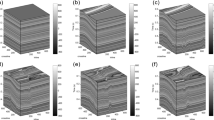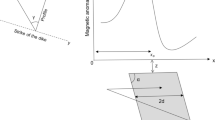Abstract
Automated interpretation of geologic features using an improved deep learning technique is a useful and progressively more acceptable tool in modeling magnetic anomalies in derivative maps. An improved deep learning model was employed to analyze magnetic derivative maps for concealed structures controlling mineralization within southwestern Nigeria’s schist-belt. This model was developed to reproduce signatures of geological features with corresponding magnetization amplitude into valid exploration criteria. This was developed by incorporating a feature engineering phase on an existing deep learning model - resunet. The automation process speeds up extraction processes and also fast-track other decision-making processes. The added phase removes noise and also strengthens the critical edge structure of magnetic images. An experiment carried out on a publicly available dataset shows promising results.






Similar content being viewed by others
References
Bencharef MH, Eldosouky AM, Zamzam S, Djamel B (2022) Polymetallic mineralization prospectivity modelling using multi-geospatial data in logistic regression: The Diapiric Zone, Northeastern Algeria. Geocarto Int 1(36). https://doi.org/10.1080/10106049.2022.2097481
Boykov Y, Marie-Pierre J (2001) Interactive graph cuts for optimal boundary & region segmentation of objects in N-D images. In: International Conference on Computer Vision, Vancouver, Canada
Carsten R, Vladimir K, Andrew B (2004) Grabcut: interactive foreground extraction using iterated graph cuts. ACM Trans Graphics 23(3):309–314
Chen GH, Lu SF, Tian SS (2014) Application of RBF neural network to logging evaluation of clay shale organic heterogeneity. J Gansu Sci 26(1):104–108. https://doi.org/10.16468/j.cnki.issn1004-0366.2014.01.010
Diakogiannis FI, Waldner F, Caccetta P, Wu C (2020) ResUNet-a: a deep learning framework for semantic segmentation of remotely sensed data. ISPRS J Photogrammetry Remote Sens 162:94–114
Dickson BL, Scott KM (1997) Interpretation of aerial gamma-ray surveys-adding the geochemical factors. J Aust Geol Geophys 17(2):187–200
Ekwok SE, Akpan AE, Achadu OM, Thompson CE, Eldosouky AM, Abdelrahman K, Andráš P (2022) Towards understanding the source of brine mineralization in Southeast Nigeria: evidence from high-resolution airborne magnetic and gravity data. Minerals 12(2):146. https://doi.org/10.3390/min12020146
Eldosouky AM, El-Qassas RAY, Pham LT, Abdelrahman K, Alhumimidi MS, ElBahrawy A, Mickus K, Sehsah H (2022a) Mapping Main Structures and Related Mineralization of the Arabian Shield (Saudi Arabia) Using Sharp Edge Detector of Transformed Gravity Data. Minerals 12(1). https://doi.org/10.3390/min12010071
Eldosouky AM, El-Qassas RAY, Pour AB, Mohamed H, Sekandari M (2021) Integration of ASTER satellite imagery and 3D inversion of aeromagnetic data for deep mineral exploration. Adv Space Res. 68(9):3641–3662. https://doi.org/10.1016/j.asr.2021.07.016
Eldosouky AM, Ekwok SE, Akpan AE, Achadu OM, Pham LT, Abdelrahman K, Gómez-Ortiz D, Alarifi SS (2022b) Delineation of structural lineaments of Southeast Nigeria using high resolution aeromagnetic data. Open Geosci 1(14):331–340. https://doi.org/10.1515/geo-2022-0360
Fu C, Lin NT, Zhang D (2018) Prediction of reservoirs using multi-component seismic data and the deep learning method. Chin J Geophys 61(1):293–303. https://doi.org/10.6038/cjg2018L0193
Gonbadi AM, Tabatabaei SH, Carranza EJM (2015) Supervised geochemical anomaly detection by pattern recognition. J Geochem Explor 157:81–91
Ji Y, Yuan S, Wang S (2016) Frequency-domain sparse Bayesian learning inversion of AVA data for elastic parameters reflectivities. J ApplGeophys 133:1–8. https://doi.org/10.1016/j.jappgeo.2016.07.016
Milligan PR, Gunn PJ (1997) Enhancement and presentation of airborne geophysical. AGSO J Aust Geol Geophys 17: 64–74
Mou D, Wang ZW, Huang YL (2015) Lithological identification of volcanic rocks from SVM well logging data: case study in the eastern depression of Liaohe Basin. Chin J Geophys 58(5):1785–1793. https://doi.org/10.6038/cjg20150528
Ogungbemi OS, Amigun JO, Olayanju GM, Badmus GO (2021) Airborne and ground geophysical evaluation of potential mineralized zone in parts of Ilesha schist belt, southwestern Nigeria. Interpretation 9(4):SH75–85
Okunlola OA, Akinola OO (2011) Physiochemical characteristics and industrial potentials of in-situ clay occurrences around Ijero-Ekiti, Southwestern Nigeria. J Fac Sci Univ Ib 8(2):114–127
Oruc B, Selim H (2011) Interpretation of magnetic data in the Sinop area of Mid Black Sea, Turkey, using tilt derivative, Euler deconvolution, and discrete wavelet transform. J Appl Geophys 74:194–204
Oyeniyi TO, Salami AA, Ojo SB (2016) Magnetic surveying as an aid to geological mapping: a case study from Obafemi Awolowo University Campus in Ile-Ife, Southwest Nigeria. Ife J Sci 18(2):331–343
Pham LH, Oliveira SP, Eldosouky AM, Abdelrahman K, Fnais MS, Xayavong V, Le Andráš PDV (2022) Determination of structural lineaments of Northeastern Laos using the LTHG and EHGA methods. J King Saud Univ Sci 34(3):101825. https://doi.org/10.1016/j.jksus.2022.101825
Pham LT, Eldosouky AM, Melouah O, Abdelrahman k, Alzahrani H, Oliveira SP, Andráš P (2021) Mapping subsurface structural lineaments using the edge filters of gravity data. J King Saud Univ - Sci 33(8):101594. https://doi.org/10.1016/j.jksus.2021.101594
Tomasi C, Manduchi R (1998) Bilateral filtering for gray and color images, Sixth International Conference on Computer Vision (IEEE Cat. No.98CH36271), pp. 839-846. https://doi.org/10.1109/ICCV.1998.710815
Twarakavi NKC, Misra D, Bandopadhyay S (2006) Prediction of arsenic in bedrock derived stream sediments at a Gold Mine Site Under Conditions of Sparse Data. Nat Resour Res 15(1):15–26
Xiao DS, Lu SF, Chen GH (2014) Mineralogy inversion based on genetic algorithm for shale gas formation. China Geoscience Conference, pp 2497–2499
Yuan S, Liu J, Wang S (2018) Seismic waveform classification and first-break picking using convolution neural networks. IEEE Geosci Remote Sens Lett 15(2):272–276. https://doi.org/10.1109/LGRS.2017.2785834
Yuan S, Wang S, Nan T (2009) Swarm intelligence optimization and its application in geophysical data inversion. Appl Geophys 6(2):166–174. https://doi.org/10.1007/s11770-009-0018-x
Zhang EH, Guan XW, Zhang YG (2011) Support vector machine in volcanic reservoir forecast: east slope in Xujiaweizi depression. Chin J Geophys 54(2):428–432. https://doi.org/10.3969/j.issn.0001-5733.2011.02.020
Zhang ZS, Zhang CM, Wang GG (1997) An interactive intelligent technology of fine structural interpretation of Diplog. Chin J Geophys 40(5):726–732
Zhang Z, Liu Q, Wang Y (2018) Road extraction by deep residual U-Net. IEEE Geosci Remote Sens Lett 15(5):749–753
Author information
Authors and Affiliations
Corresponding author
Ethics declarations
Declarations
We the above-listed authors declare that there is no conflict of interest on this article.
Additional information
Communicated by H. Babaie
Publisher’s Note
Springer Nature remains neutral with regard to jurisdictional claims in published maps and institutional affiliations.
Rights and permissions
Springer Nature or its licensor holds exclusive rights to this article under a publishing agreement with the author(s) or other rightsholder(s); author self-archiving of the accepted manuscript version of this article is solely governed by the terms of such publishing agreement and applicable law.
About this article
Cite this article
Ogungbemi, O.S., Oyebode, K., Badmus, G.O. et al. Modeling of structural features from aeromagnetic maps using an improved deep learning technique. Earth Sci Inform 15, 2665–2671 (2022). https://doi.org/10.1007/s12145-022-00870-z
Received:
Revised:
Accepted:
Published:
Issue Date:
DOI: https://doi.org/10.1007/s12145-022-00870-z




